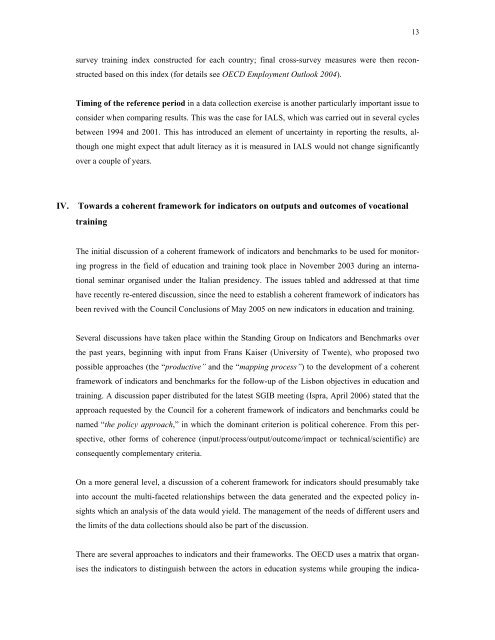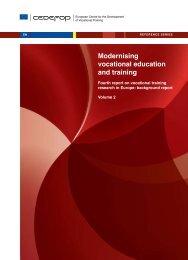measuring the outputs and outcomes of vocational training
measuring the outputs and outcomes of vocational training
measuring the outputs and outcomes of vocational training
Create successful ePaper yourself
Turn your PDF publications into a flip-book with our unique Google optimized e-Paper software.
13<br />
survey <strong>training</strong> index constructed for each country; final cross-survey measures were <strong>the</strong>n reconstructed<br />
based on this index (for details see OECD Employment Outlook 2004).<br />
Timing <strong>of</strong> <strong>the</strong> reference period in a data collection exercise is ano<strong>the</strong>r particularly important issue to<br />
consider when comparing results. This was <strong>the</strong> case for IALS, which was carried out in several cycles<br />
between 1994 <strong>and</strong> 2001. This has introduced an element <strong>of</strong> uncertainty in reporting <strong>the</strong> results, although<br />
one might expect that adult literacy as it is measured in IALS would not change significantly<br />
over a couple <strong>of</strong> years.<br />
IV. Towards a coherent framework for indicators on <strong>outputs</strong> <strong>and</strong> <strong>outcomes</strong> <strong>of</strong> <strong>vocational</strong><br />
<strong>training</strong><br />
The initial discussion <strong>of</strong> a coherent framework <strong>of</strong> indicators <strong>and</strong> benchmarks to be used for monitoring<br />
progress in <strong>the</strong> field <strong>of</strong> education <strong>and</strong> <strong>training</strong> took place in November 2003 during an international<br />
seminar organised under <strong>the</strong> Italian presidency. The issues tabled <strong>and</strong> addressed at that time<br />
have recently re-entered discussion, since <strong>the</strong> need to establish a coherent framework <strong>of</strong> indicators has<br />
been revived with <strong>the</strong> Council Conclusions <strong>of</strong> May 2005 on new indicators in education <strong>and</strong> <strong>training</strong>.<br />
Several discussions have taken place within <strong>the</strong> St<strong>and</strong>ing Group on Indicators <strong>and</strong> Benchmarks over<br />
<strong>the</strong> past years, beginning with input from Frans Kaiser (University <strong>of</strong> Twente), who proposed two<br />
possible approaches (<strong>the</strong> “productive” <strong>and</strong> <strong>the</strong> “mapping process”) to <strong>the</strong> development <strong>of</strong> a coherent<br />
framework <strong>of</strong> indicators <strong>and</strong> benchmarks for <strong>the</strong> follow-up <strong>of</strong> <strong>the</strong> Lisbon objectives in education <strong>and</strong><br />
<strong>training</strong>. A discussion paper distributed for <strong>the</strong> latest SGIB meeting (Ispra, April 2006) stated that <strong>the</strong><br />
approach requested by <strong>the</strong> Council for a coherent framework <strong>of</strong> indicators <strong>and</strong> benchmarks could be<br />
named “<strong>the</strong> policy approach,” in which <strong>the</strong> dominant criterion is political coherence. From this perspective,<br />
o<strong>the</strong>r forms <strong>of</strong> coherence (input/process/output/outcome/impact or technical/scientific) are<br />
consequently complementary criteria.<br />
On a more general level, a discussion <strong>of</strong> a coherent framework for indicators should presumably take<br />
into account <strong>the</strong> multi-faceted relationships between <strong>the</strong> data generated <strong>and</strong> <strong>the</strong> expected policy insights<br />
which an analysis <strong>of</strong> <strong>the</strong> data would yield. The management <strong>of</strong> <strong>the</strong> needs <strong>of</strong> different users <strong>and</strong><br />
<strong>the</strong> limits <strong>of</strong> <strong>the</strong> data collections should also be part <strong>of</strong> <strong>the</strong> discussion.<br />
There are several approaches to indicators <strong>and</strong> <strong>the</strong>ir frameworks. The OECD uses a matrix that organises<br />
<strong>the</strong> indicators to distinguish between <strong>the</strong> actors in education systems while grouping <strong>the</strong> indica-








